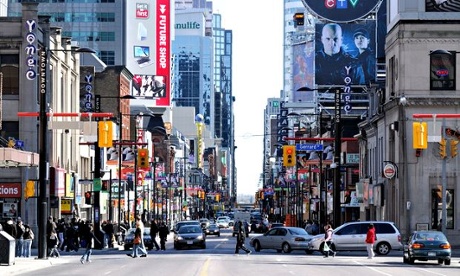
Yonge Street is Toronto’s spine – and the longest street in the world too [recognised by the Guinness Book of Records in 1988], going on for hundreds of miles into northern Ontario. It starts at Lake Ontario and from there you can stroll up to the Eaton Centre, a massive, rather spectacular, mall. Follow Yonge up to Bloor Street and once you get to the intersection you’ll be in a shopping district of mainly high-end stores. But Bloor Street also has a little pocket neighbourhood, called Yorkville, that’s great to explore.
On a clear day you can see Niagara Falls from the top of the CN Tower. It’s still one of the tallest buildings in Canada, and if you’re brave enough you could try its EdgeWalk, where you can walk on and around the roof of the tower’s main pod – 356 metres up.
The best green space in the downtown area is High Park – all 161 hectares of it. It’s perfect for picnics and relaxing, there’s a small zoo and also Shakespeare in the Park outdoor performances here during the summer.
There is a spectacular view of the city from the Toronto Islands. They are just a 10-minute ferry ride from downtown (C$7 return). Once you’re there, you don’t hear the city traffic anymore. There are a lot of old cottages on the islands that people actually live in – they have leased them from the city. You can rent a bicycle and ride along little laneways. You’re only a mile or so from the city but it feels like they are 200 miles north, in the countryside.
Public transport is a subject of much debate here. There are only four subway lines and two of them are really short. You can easily find a cab, and there’s a network of surface transport, such as buses and streetcars (trams) but these can often get caught in traffic. It can sometimes take time to get to where you want to go but you will get there – it’s not horrendous all the time.
The Frank Gehry redesign of the Art Gallery of Ontario on Dundas Street West is spectacular, and the gallery is one of many gorgeous buildings around the city. Behind it is OCAD University (formerly the Ontario College of Art and Design), which looks like an immense rectangular box, with black and white squares all over it. The impression it gives is of being suspended in the air by these red and blue toothpick-like legs. People either love it or hate it.
At the Library Bar of the Fairmount Royal York they have several drinks named after Canadian authors. I discovered that you can even have a Linwood Barclay negroni (C$16). I’m not much of a drinker, so I only just got through it, but I know others who have loved it. I thought getting my name on a book cover wasn’t bad, but now there’s a cocktail named after me I feel I’ve made it!
Toronto is a city that loves its books. There’s a rich literary heritage here and some wonderful bookshops, too – in particular for crime fiction at Sleuth of Baker Street on Millwood Road. There are also two book festivals to check out. In September there’s The Word on the Street, which takes up this huge park area north of the provincial legislature building at Queen’s Park Circle. Then, there’s the International Festival of Authors, starting on 23 October. It draws writers from all over the world: Stephen King was there last year, and Ian Rankin regularly attends. It’s one of the most highly regarded authors’ festivals in the world.
A Toronto hidden gem would have to be the rooftop bar at the Park Hyatt on Avenue Road in downtown. It’s actually called the Roof Lounge and is on the 18th floor, so has fantastic views over Yorkville and the rest of the city. The patio is heated so you can enjoy it pretty much all year round.
If you’re an adventurous eater there’s everything you could want in Toronto because there are so many cultures represented. However, I’m the kind of guy who goes to the same restaurant all the time and orders the same thing. I love Terroni – it’s a family-run chain and they have three restaurants in the city serving great Italian food.
The majority of what you’ll want to see is in downtown, but Toronto is a city that sprawls out into a lot of interesting neighbourhoods. The region is mostly flat, certainly the area around Lake Ontario that heads off towards Buffalo, New York state. It’s like pouring a glass of water on a flat table … it just keeps spreading out.
People have preconceptions about Toronto. They probably think there are Mounties in red coats everywhere, that there is tons of snow in July and that it’s heavily French. None of these is true. Summers are hot and humid, you are unlikely to spot a Mountie unless there is a ceremony of some sort, and French is not a major language here. It’s probable that more people are speaking Italian and Chinese in Toronto than they are French.
I think that if architecture doesn’t get in your face sometimes, nobody will pay any attention to it. And people definitely have a love-hate situation going on with Daniel Libeskind’s The Crystal, which became the new main entrance to the Royal Museum of Ontario in 2007. It is such a juxtaposition of architectural styles – because this big, glass crystal bursts out of what is otherwise an old-fashioned, classic museum building.
• Linwood Barclay’s new thriller, No Safe House, is out now in hardback (published by Orion, £16.99). To buy a copy for £12.64 including UK p&p visit bookshop.theguardian.com or call on 0330 333 6846

